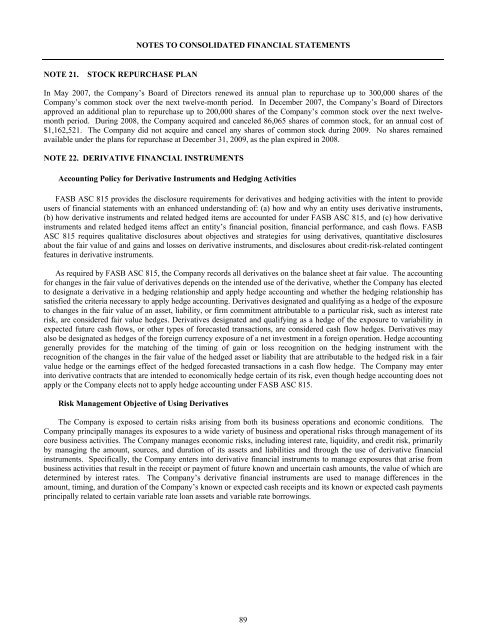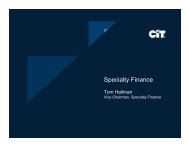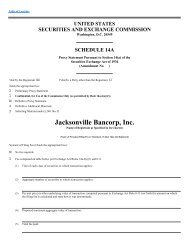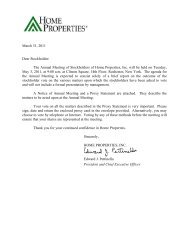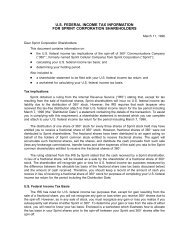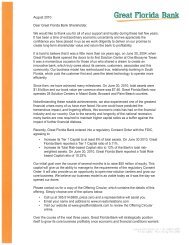pab bankshares, inc. - SNL Financial
pab bankshares, inc. - SNL Financial
pab bankshares, inc. - SNL Financial
Create successful ePaper yourself
Turn your PDF publications into a flip-book with our unique Google optimized e-Paper software.
NOTES TO CONSOLIDATED FINANCIAL STATEMENTS<br />
NOTE 21.<br />
STOCK REPURCHASE PLAN<br />
In May 2007, the Company’s Board of Directors renewed its annual plan to repurchase up to 300,000 shares of the<br />
Company’s common stock over the next twelve-month period. In December 2007, the Company’s Board of Directors<br />
approved an additional plan to repurchase up to 200,000 shares of the Company’s common stock over the next twelvemonth<br />
period. During 2008, the Company acquired and canceled 86,065 shares of common stock, for an annual cost of<br />
$1,162,521. The Company did not acquire and cancel any shares of common stock during 2009. No shares remained<br />
available under the plans for repurchase at December 31, 2009, as the plan expired in 2008.<br />
NOTE 22. DERIVATIVE FINANCIAL INSTRUMENTS<br />
Accounting Policy for Derivative Instruments and Hedging Activities<br />
FASB ASC 815 provides the disclosure requirements for derivatives and hedging activities with the intent to provide<br />
users of financial statements with an enhanced understanding of: (a) how and why an entity uses derivative instruments,<br />
(b) how derivative instruments and related hedged items are accounted for under FASB ASC 815, and (c) how derivative<br />
instruments and related hedged items affect an entity’s financial position, financial performance, and cash flows. FASB<br />
ASC 815 requires qualitative disclosures about objectives and strategies for using derivatives, quantitative disclosures<br />
about the fair value of and gains and losses on derivative instruments, and disclosures about credit-risk-related contingent<br />
features in derivative instruments.<br />
As required by FASB ASC 815, the Company records all derivatives on the balance sheet at fair value. The accounting<br />
for changes in the fair value of derivatives depends on the intended use of the derivative, whether the Company has elected<br />
to designate a derivative in a hedging relationship and apply hedge accounting and whether the hedging relationship has<br />
satisfied the criteria necessary to apply hedge accounting. Derivatives designated and qualifying as a hedge of the exposure<br />
to changes in the fair value of an asset, liability, or firm commitment attributable to a particular risk, such as interest rate<br />
risk, are considered fair value hedges. Derivatives designated and qualifying as a hedge of the exposure to variability in<br />
expected future cash flows, or other types of forecasted transactions, are considered cash flow hedges. Derivatives may<br />
also be designated as hedges of the foreign currency exposure of a net investment in a foreign operation. Hedge accounting<br />
generally provides for the matching of the timing of gain or loss recognition on the hedging instrument with the<br />
recognition of the changes in the fair value of the hedged asset or liability that are attributable to the hedged risk in a fair<br />
value hedge or the earnings effect of the hedged forecasted transactions in a cash flow hedge. The Company may enter<br />
into derivative contracts that are intended to economically hedge certain of its risk, even though hedge accounting does not<br />
apply or the Company elects not to apply hedge accounting under FASB ASC 815.<br />
Risk Management Objective of Using Derivatives<br />
The Company is exposed to certain risks arising from both its business operations and economic conditions. The<br />
Company pr<strong>inc</strong>ipally manages its exposures to a wide variety of business and operational risks through management of its<br />
core business activities. The Company manages economic risks, <strong>inc</strong>luding interest rate, liquidity, and credit risk, primarily<br />
by managing the amount, sources, and duration of its assets and liabilities and through the use of derivative financial<br />
instruments. Specifically, the Company enters into derivative financial instruments to manage exposures that arise from<br />
business activities that result in the receipt or payment of future known and uncertain cash amounts, the value of which are<br />
determined by interest rates. The Company’s derivative financial instruments are used to manage differences in the<br />
amount, timing, and duration of the Company’s known or expected cash receipts and its known or expected cash payments<br />
pr<strong>inc</strong>ipally related to certain variable rate loan assets and variable rate borrowings.<br />
89


